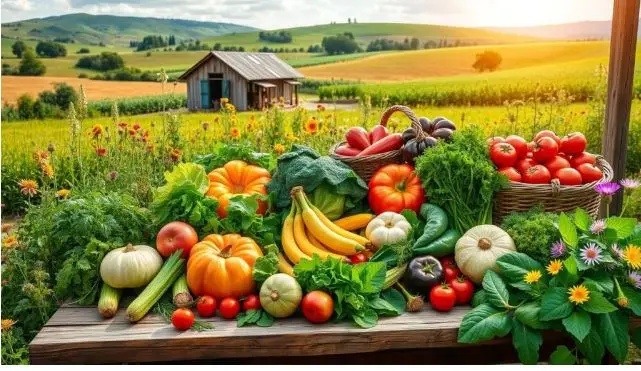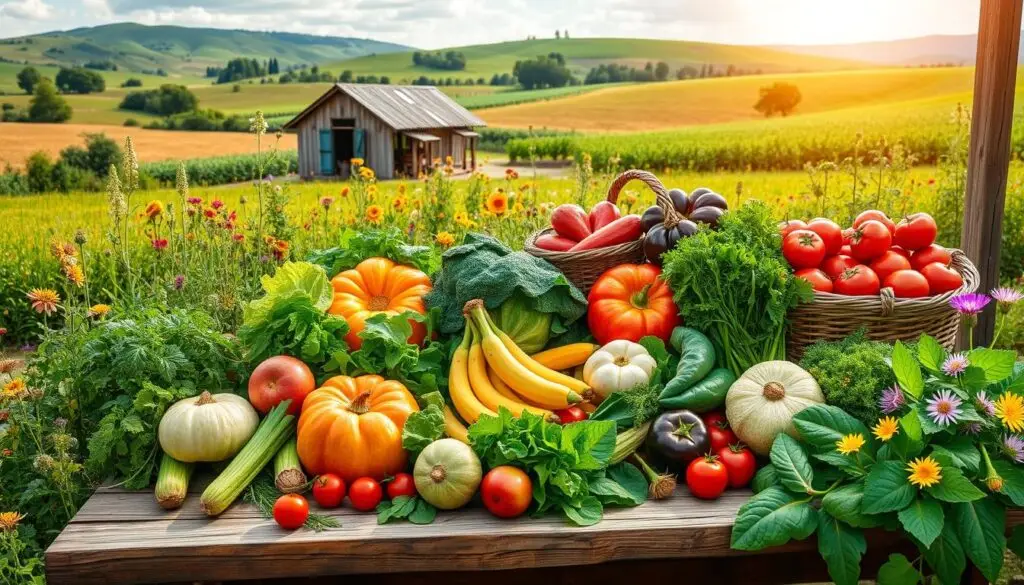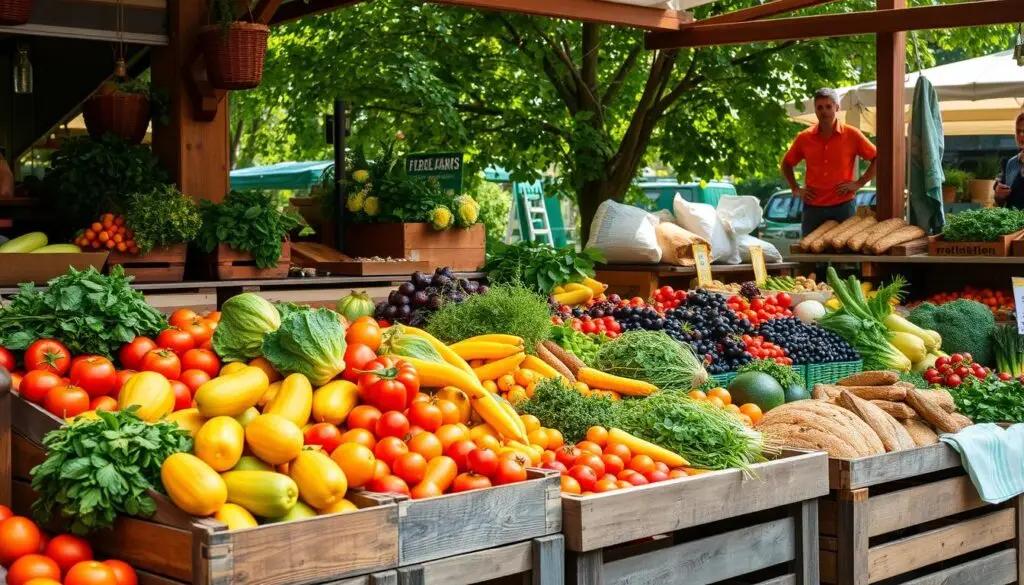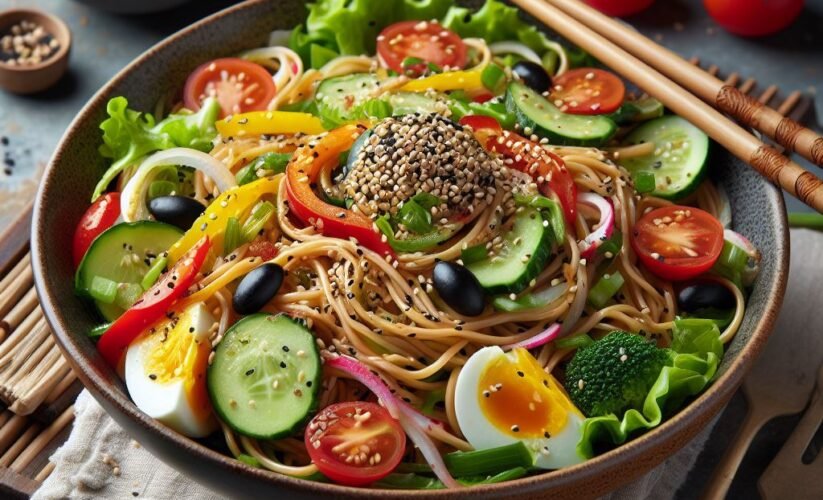
Seasonal Cooking: Embracing Fresh Ingredients Year-Round
Ever thought about how seasonal cooking can change your meals and health? Using fresh ingredients all year is more than a food choice. It’s a way to connect with the foods of each season. This article shows the beauty and benefits of choosing local produce.
It highlights how it can make your diet better and help local farmers. You’ll see how seasonal cooking makes meals tastier and healthier. It also helps the planet.
Key Takeaways
- Seasonal cooking enhances flavor and nutrition.
- Choosing local produce supports regional farmers and economies.
- Eating with the seasons reduces environmental impact.
- Fresh ingredients contain higher levels of vitamins and minerals.
- Engaging in seasonal cooking promotes a sustainable lifestyle.
The Benefits of Seasonal Cooking
Seasonal cooking has many benefits for our health and the environment. It makes meals not only tasty but also full of nutrients. This way, we get to enjoy food that’s good for us.
Healthier Meals with Fresh Ingredients
Using fresh, seasonal ingredients makes our meals healthier. These foods are packed with vitamins and antioxidants that boost our health. When we eat food that’s picked at the peak of ripeness, it’s more nutritious.
This method improves the quality of our meals. It also helps us eat in a way that’s better for our health.
Environmental Impact of Seasonal Choices
Choosing local produce is great for the environment. It cuts down on the need for fossil fuels and reduces greenhouse gas emissions. By supporting local farmers, we also avoid chemicals and preservatives needed for long-distance transport.
This choice helps our local economies grow. It promotes sustainability in our communities.
| Benefit | Description |
|---|---|
| Higher Nutritional Value | Seasonal produce contains more vitamins and minerals. |
| Reduced Carbon Footprint | Minimizing food transportation lowers greenhouse gas emissions. |
| Support for Local Farmers | Buying local contributes to the local economy. |
| Enhanced Flavor | Fresh ingredients are often tastier and more vibrant. |
| Lower Use of Preservatives | Freshly harvested foods require fewer additives. |
Understanding the Farm-to-Table Movement
The Farm-to-Table movement connects consumers directly with local farms. It focuses on using seasonal produce and being open about where food comes from. This can change how families choose fresh ingredients for their meals.
What is Farm-to-Table Cuisine?
Farm-to-Table Cuisine is about eating fresh, local food. It uses ingredients that are in season, cutting down on food travel. This way of eating supports local farmers and helps the environment.
The Role of Local Farms in Seasonal Cooking
Local farms are key in the Farm-to-Table movement. They offer a variety of fruits and veggies for seasonal cooking. Buying directly from these farms means better-tasting food and helps local farmers succeed.
Exploring Local Produce Availability
Knowing when local produce is available helps you cook fresh meals all year. Each region has its own growing seasons. This means knowing what fruits and veggies are in season is key.
By staying up-to-date, you can plan meals that highlight the best flavors and nutrients. This makes your dishes more vibrant and nutritious.
When to Find Seasonal Fruits and Vegetables
Seasonal fruits and veggies are plentiful at certain times. Here’s a guide to help you find them:
| Season | Fruits | Vegetables |
|---|---|---|
| Spring | Strawberries, Apricots | Asparagus, Spinach |
| Summer | Peaches, Watermelon | Tomatoes, Bell Peppers |
| Autumn | Apples, Pumpkins | Brussels Sprouts, Squash |
| Winter | Citrus Fruits, Pears | Root Vegetables, Kale |
How to Choose the Best Local Produce
Picking the right produce is crucial for great meals. Here are some tips:
- Examine Color: Look for vibrant colors, indicating ripeness.
- Check Firmness: Gently squeeze fruits and vegetables; they should feel firm but not hard.
- Inhale Aroma: Fresh produce often has a pleasant, earthy scent.
- Observe Seasonal Timing: Be mindful of local produce availability to find items that are in season.
Seasonal Cooking: Embracing Fresh Ingredients Year-Round
Adding seasonal ingredients to your meals is rewarding. It makes food taste better and is healthier. By using what’s in season, you get to enjoy a wide range of flavors all year.
Planning meals around the seasons boosts your health and taste. It connects you to nature’s rhythms.
Integrating Seasonal Ingredients into Your Diet
To add seasonal ingredients to your meals, follow these tips:
- Plan your menu: Organize your meals around what’s fresh at farmers’ markets or stores.
- Experiment with recipes: Try new dishes that show off each season’s unique flavors.
- Keep a rotating pantry: Stock up on seasonal items to easily change up your meals.
Seasonal cooking makes cooking fun and creative. It leads to healthier meals and helps the planet. It also deepens your appreciation for food.
| Season | In-season Produce | Recipe Idea |
|---|---|---|
| Spring | Asparagus, peas, strawberries | Spring Vegetable Stir-Fry |
| Summer | Tomatoes, corn, peaches | Fresh Salsa with Grilled Corn |
| Autumn | Pumpkins, apples, beets | Roasted Pumpkin Soup |
| Winter | Brussels sprouts, kale, citrus | Kale and Citrus Salad |
With a smart plan, you can make your meals better all year. Enjoy the health benefits of fresh food. This lifestyle makes your diet vibrant and supports nature.
Delicious Seasonal Recipes for Every Month
Home cooks can enjoy fresh ingredients every month by making seasonal recipes. This way, they can try new flavors that come with each season. It makes cooking exciting and adds flavor to meals.
Spring-Inspired Recipes
Spring brings fresh produce like asparagus, peas, and radishes. These can be the stars in spring recipes. Try a spring vegetable risotto or a simple pea and mint salad for a refreshing taste.
Summer Delights with Fresh Fruit
Summer is all about sweet flavors, especially with fresh fruits. Juicy berries, peaches, and tomatoes are in season. Make a vibrant tomato salad with basil or a berry tart to enjoy summer’s sweetness.
Autumn Harvest Treats
Autumn brings cooler weather and hearty ingredients. Root vegetables and squash are perfect for cooking. Try pumpkin soup or a roasted root vegetable medley to celebrate the season’s flavors.
Winter Comfort Food with Organic Ingredients
Winter is for warm, nourishing meals. Use organic ingredients like winter greens and legumes for soups and stews. A cozy lentil stew or a creamy kale and potato bake will keep you warm.
| Season | Key Ingredients | Recipe Ideas |
|---|---|---|
| Spring | Asparagus, Peas, Radishes | Spring Vegetable Risotto, Pea and Mint Salad |
| Summer | Berries, Peaches, Tomatoes | Tomato Basil Salad, Berry Tart |
| Autumn | Carrots, Squash, Root Vegetables | Pumpkin Soup, Roasted Root Veggies |
| Winter | Winter Greens, Legumes | Lentil Stew, Kale and Potato Bake |
The Importance of Sustainable Eating
Sustainable eating means making choices that are good for you and the planet. It’s about picking organic ingredients, which are grown without harmful chemicals. These choices lead to healthier meals and support farming that keeps our environment balanced.
Choosing Organic Ingredients
Choosing organic ingredients is key to sustainable eating. Organic farming boosts biodiversity and keeps soil healthy with natural methods. It avoids synthetic chemicals, giving us cleaner food.
Organic food often comes from nearby, cutting down on carbon emissions from transport. Making these choices helps create a better food system, benefiting both our health and the environment.
Understanding Sustainable Practices in Cooking
Using sustainable cooking methods makes eating sustainable even better. Practices like composting, using reusable containers, and reducing waste are good for the planet. They also make cooking more enjoyable.
These actions help reduce waste and support a food economy that’s circular. Cooking sustainably lets us enjoy tasty meals while protecting our planet.
Regional Flavors: A Journey Through Seasonal Cooking
Exploring regional flavors makes seasonal cooking more exciting. It shows off local ingredients that reflect the U.S.’s diverse climate and culture. Each region has its own dishes that celebrate local produce and traditions. This lets home cooks create meals full of history and flavor.
Flavors of the Northeast
Northeast cuisine is known for fresh apples, cranberries, and root vegetables. Dishes like apple crisp and cranberry sauce show off the region’s bounty. The cold weather leads to hearty soups and stews made with local ingredients.
Southwestern Culinary Traditions
Southwestern dishes are bold and spicy, thanks to fresh peppers and beans. Tomatillos, chili peppers, and corn make up iconic dishes like enchiladas and chili. This region loves bold flavors and big portions, showing off its vibrant farms.
West Coast Seasonal Offerings
The West Coast is famous for fresh seafood, avocados, and nuts. These ingredients inspire dishes like grilled fish tacos and salads with nuts. The focus on sustainability and organic farming makes meals here special, honoring the land and culture.
Visiting Farmers’ Markets Near You
Farmers’ markets are a great place to buy local produce. They let you connect with the people who grow your food. You can find fresh ingredients and build a bond with local farmers.
How to Make the Most of Your Farmers’ Market Trip
Here are some tips to make the most of your visit:
- Arrive early for the freshest selection.
- Engage with farmers and ask questions about their growing practices.
- Taste samples to discover new flavors.
- Bring reusable bags to carry your produce sustainably.
These tips will help you learn more about local produce. You’ll also find seasonal treasures.
Building Relationships with Local Farmers
Getting to know local farmers is rewarding. It helps you understand what’s in season and how to prepare it. Regular visits build trust and let you know about new crops and products.
Vegetable Gardening: Grow Your Own Fresh Ingredients
Vegetable gardening lets you grow your own food. It’s a fun hobby that lets you control what you eat. Starting with easy veggies makes it fun for everyone.
Easy Vegetables to Start Growing
Some veggies are great for beginners. Here are some easy ones to try:
- Tomatoes
- Cucumbers
- Lettuce
- Radishes
- Herbs like basil and parsley
Maintaining a Year-Round Garden
To have fresh veggies all year, try these tips:
- Use raised beds or containers for better drainage.
- Try indoor gardening in cold weather.
- Use cold frames or greenhouses to grow longer.
- Choose perennial veggies that come back every year.
There are many resources for new gardeners. Vegetable gardening is rewarding. It brings joy, health, and fresh ingredients all year.
| Vegetable | Growing Season | Sunlight Requirement | Harvest Time |
|---|---|---|---|
| Tomatoes | Spring to Fall | Full sun | 70-85 days |
| Cucumbers | Spring to Summer | Full sun | 50-70 days |
| Lettuce | Spring to Fall | Partial shade | 30-60 days |
| Radishes | Spring to Fall | Full sun | 25-30 days |
| Basil | Spring to Fall | Full sun | 60-90 days |
Food Preservation Techniques for Seasonal Ingredients
Food preservation techniques are key to using seasonal ingredients fully. Methods like canning, freezing, dehydrating, and pickling help keep food fresh longer. This way, we can enjoy the taste of fresh produce even when it’s not in season.
Using these techniques helps in reducing food waste. It also makes meal prep easier during off-peak seasons. Families can enjoy local harvest flavors all year without worrying about spoilage.
To preserve food well, you’ll need some basic tools and resources. These include:
- Glass jars for canning
- Vacuum sealers for freezing
- Food dehydrators for drying fruits and vegetables
- Pickling supplies for creating tangy vegetable snacks
Here’s a look at some common preservation methods:
| Technique | Best For | Shelf Life | Flavor Retention |
|---|---|---|---|
| Canning | Fruits, vegetables, sauces | 1-2 years | Good |
| Freezing | Almost all fresh produce | 6 months to 2 years | Excellent |
| Dehydrating | Herbs, fruits, vegetables | 1-2 years | Very good |
| Pickling | Vegetables, fruits | 1 year | Unique flavor |
By using these preservation techniques, you can improve your cooking and keep your favorite seasonal ingredients ready all year.
Conclusion: Embracing Seasonal Cooking for a Healthier Lifestyle
Embracing seasonal cooking is key to a healthier lifestyle. It lets you enjoy fresh, local ingredients. This makes your meals taste better and are more nutritious.
It also helps the environment by supporting sustainable farming. You get to enjoy each season’s special foods. This makes you appreciate the variety of nature’s offerings.
Seasonal cooking also makes mealtime more fun. You get to try new recipes and ingredients. This keeps your diet interesting and ensures you get all the nutrients you need.
By using seasonal ingredients, you eat more mindfully. This leads to a healthier lifestyle. You’ll find joy in eating in harmony with nature.





